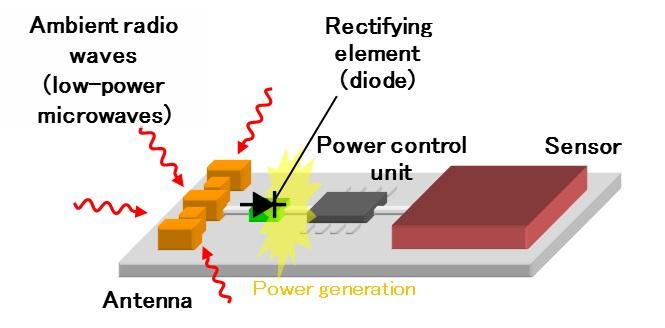Aiming to create sensor networks that do not require dedicated power sources

Credit: ©Fujitsu Ltd.
The Japan Science and Technology Agency (JST), Fujitsu Limited, and the Tokyo Metropolitan University announced that they developed a highly sensitive rectifying element in the form of a nanowire backward diode, which can convert low-power microwaves into electricity. Through JST’s Strategic Basic Research Programs, the technology was developed by researchers led by Kenichi Kawaguchi of Fujitsu Limited and Professor Michihiko Suhara of the Tokyo Metropolitan University. The new technology is expected to play a role in harvesting energy from radio waves in the environment, in which electricity is generated from ambient radio waves, such as those emitted from mobile phone base stations.
Research Background and Circumstances
In preparation for the commencement of the true IoT era, energy harvesting technologies, which transform the minute sources of energy in the surrounding environment into electricity, have come under the spotlight in recent years as means for creating sensor networks that function without batteries. One such example reuses as electricity the low-power radio waves (microwaves), ubiquitous in open space, that are emitted from mobile phone base stations, for use in communications. Equipment used in generating electricity from ambient radio waves consists of a radio wave power generating element, which includes an antenna for collecting radio waves and a rectifying element (diode) that rectifies the radio waves (figure 1).
The responsiveness (sensitivity) of a diode to microwaves largely depends on the steepness of rectification characteristics and on diode size (capacity). Generally, Schottky*1 barrier diodes, which utilize the rectification occurring at the junction formed between a metal and a semiconductor, are used as the diodes for power conversion. Due to rectification characteristics becoming slow at extremely low voltages and the size of elements being larger than several micrometers (μm), however, sensitivity to low-power microwaves weaker than microwatts (μW) was insufficient, and it was difficult to convert ambient radio waves into electricity. This led to a demand for diodes with increased sensitivity.
Research Details
The researchers carried out development to create a diode with higher sensitivity. Specifically, they shrunk the capacity of and miniaturized a backward diode*2 that is capable of steep rectification operations with zero bias *3, as rectification occurs by joining two different types of semiconductors and current flows with a different principle (tunnel effect) than conventional Schottky barrier diodes.
Conventional backward diodes were formed by processing the thin film of a layered compound semiconductor into a disk shape via etching. Nonetheless, because the materials are prone to damage under processing, it was difficult to finely process diodes to a submicron size and operate them.
By adjusting the ratio (composition) of the constituent elements of the connected semiconductor materials and, at a minute level, the density of the added impurities, the researchers succeeded in growing crystals in nanocrystals with a diameter of 150nm comprised of n-type indium arsenide (n-InAs) and p-type gallium arsenide antimonide (p-GaAsSb) for a tunnel junction structure necessary for the characteristics of the backward diode. Moreover, in the process for implanting insulating material around the nanowire*4 and the process for forming electrode film with metal on both end of the wire, a new technology was used for mounting that does not damage the nanowire. As a result, they were able to form a sub-micron sized diode, which was difficult to do with conventional miniaturization process technology for compound semiconductors, and thereby succeeded, for the first time in the world, in developing a nanowire backward diode with over 10 times the sensitivity of conventional Schottky barrier diodes (figure 2).
In testing the new technology in the microwave frequency of 2.4GHz, which is currently used in the 4G LTE and Wi-Fi communication line standards for mobile phones, the sensitivity was 700kV/W, roughly 11 times that of the conventional Schottky barrier diode (with a sensitivity of 60KV/W) (figure 3). Therefore, the technology can efficiently convert 100nW-class low-power radio waves into electricity, enabling the conversion of microwaves emitted into the environment from mobile phone base stations in an area that is over 10 times greater than was previously possible (corresponding to 10% of the area in which mobile phone communications are possible). This has led to expectations that it can be used as a source of power for sensors.
With this technology, microwaves with a power level of 100 nanowatts (nW) can be converted to electricity. Going forward, as the research group optimize the design of the diode and the radio wave-collecting antenna while adding power control for constant voltage, there are high expectations for the realization of energy harvesting from environmental radio waves.
###
Notes
1. Schottky barrier diode: Diodes that use the energy known as a Schottky barrier, which is produced through a junction of a semiconductor and metal, for rectification.
2. Backward diode: In contrast to conventional Schottky barrier diodes, these diodes operate by using the phenomenon of tunneling. They enable excellent rectification operations even within small voltage ranges in which conventional diodes are unable to achieve sufficient rectification.
3. Zero bias: A condition in which there is zero voltage. With the harvesting of energy from environmental radio waves, zero bias operations are needed because power cannot be consumed for the adjustment of the operating voltage.
4. Nanowire: Wire-shaped semiconductors so thin that their width is measured in nanometers (nm). Rather than through top-down processing such as etching, they can be built bottom up through crystal formation.
Media Contact
Kenichi Kawaguchi
[email protected]
Original Source
https:/




